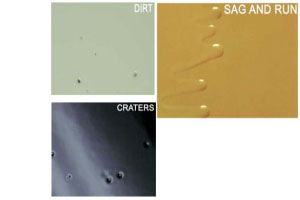

Coatings, such as paints and polyurethane sealants, are an important part of our lives. If you can think of a surface, whether it’s a wall, floor, ceiling, table top, or counter, chances are that it’s covered in some kind of coating that’s meant to protect it, beautify it, or both.
Construction firms and manufacturers from an array of industries depend on high-performance coatings, whether they are waterproofing a building’s exterior or applying non-corrosive paint to metal products. Sometimes, however, coatings fail to perform, and the reason can come from one or more directions.
Let’s take a look at some of the main reasons that coatings sometimes fail or become defective.
Often, a coating’s failure to perform can have nothing to do with the quality or formulation of the coating, but rather how the applicator has prepared the substrate, or surface to which the coating is being applied. When the substrate is inadequately prepared, the coating is unable to achieve sufficient cohesion with it.
Surfaces must be clean, free of chemical and other surface contaminants prior to application. Failure to properly prepare the surface could lead to immediate failure or hamper long-term performance of the coating. For example, a coating may “blister” when it covers a surface with even small amounts of moisture or soluble salts. You can tell if a coating is blistering when little domed spots occur, spots that look much like a blister on human skin. If the wet area prevents the coating from adhering at all, then a blister takes shape.
When applicators fail to properly clean a surface, leaving small contaminants, another phenomenon, cratering, occurs. You’ll hear those of us in the coatings industry often refer to this occurrence as “fish eyes,” a colorful way of describing the small craters left behind as the coating dries. Other common failures due to improper substrate preparation include detaching, uneven gloss, crawling, and improper wetting.
Environmental considerations, especially at time of application, can cause a coating to fail quickly and badly. Coatings are formulated to be applied within a certain normal range of conditions, and extreme temperatures, humidity, and air quality can hamper a successful application.
For example, when the room or outdoor temperature, known as the ambient temperature, is too hot or too cold, the coating may not flow as a continuous wet film. Also, if a coating is applied in conditions below the dew point, you’ll see water spotting, caused by moisture being trapped between the coating and the substrate. Finally, you’ll see a phenomenon called blushing occur when a coating is sensitive to humidity. The resulting finish contains a milky white color that can make an entire application, or significant sections, look entirely different than intended.
In the paints & coatings industry, we design our formulas with specific application methods in mind. When an applicator doesn’t follow the prescribed application technique, by spray (by airless, conventional air, electrostatic, or high-volume, low-pressure), dip, brush, or roll, problems can and usually will occur.
When you use the wrong application technique, you’ll see failure in a number of possible ways. Perhaps most commonly seen is an effect we call “orange peel,” where the coating is rendered with pockmarks throughout, resembling the outer skin of an orange, as opposed to a smooth surface. You’ll also see sagging, where the coating droops downward due to its inability to fight gravity with tight adherence to the substrate.
A good example of preventive application method can be the use of stripe coats. These are coats done by painters on flanges, beams, and other substrates featuring sharp edges. Even when you’re using a one-coat application, failure to apply the stripe coat can mean failure to keep the right amount of the coating at the edges.
Sometimes, a coating will fail simply because it’s not the right tool for the job, due to a defective design. There are many factors to take into account when designing a coating formula. Industrial coatings should align perfectly to their end use environment, as well as the most common application techniques for that environment. Some coatings must perform in extreme temperatures, while others must work while submerged in water (think about coatings used for a boat hull). Immersion coatings must deal with a set of unique conditions common to tank liners. They must deal with the gravity associated with vertical application, as well as withstanding the effects of whatever liquid the tank is designed to hold, whether it’s water, a chemical compound, or oilfield product.
As you’d expect, your coatings manufacturer also needs precise information with regard to the techniques you’ll be using, whether it’s brushing, rolling, or a specific type of sprayer. When you make proper allowances for your environment and the ways you’ll be applying a paint or coating, your manufacturer should be able to deliver a high-performance application that avoids cracking, erosion, and the other failures caused by inexact formulation.
Any time you hear reports of a coating failure, it’s important to do an analysis to pinpoint the exact reason that your coating is failing to do the job. At Riteks, we not only offer a lineup of high-performance paints and coatings, but also consult with our customers to find points of failure to optimize future batches to do the job right.
If you need to take your coatings to the next level, contact Riteks today.